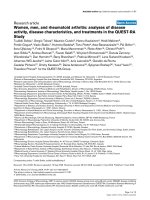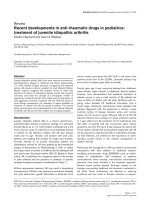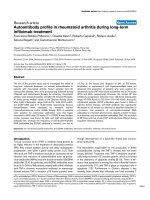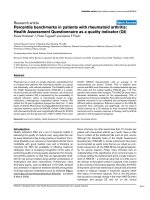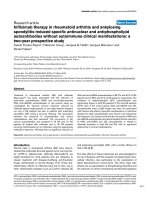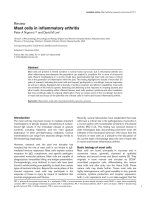Báo cáo y học: "Rituximab treatment in rheumatoid arthritis: how does it work" pdf
Bạn đang xem bản rút gọn của tài liệu. Xem và tải ngay bản đầy đủ của tài liệu tại đây (42.8 KB, 2 trang )
Available online />Page 1 of 2
(page number not for citation purposes)
Abstract
Treatment with the chimerical monoclonal antibody rituximab
results in CD20-directed B cell depletion. Although this depletion
is almost complete in the peripheral blood of nearly all patients with
rheumatoid arthritis, a proportion of patients does not exhibit a
clinical response. The paper by Nakou and colleagues suggests
that a decrease in CD19+CD27+ memory B cells in both
peripheral blood and bone marrow precedes the clinical response
to rituximab. This finding adds to the emerging evidence that lack
of response to rituximab is associated with persistence of B
lineage cells in specific body compartments.
In a recent issue of Arthritis, Research & Therapy, Nakou and
colleagues [1] present an interesting study of the effects of
rituximab treatment on B cell subsets in both peripheral blood
and bone marrow of patients with rheumatoid arthritis (RA). In
2001, Edwards and Cambridge [2] successfully performed
the first pilot trial evaluating B cell depletive therapy in five
patients with RA. The beneficial effect of treatment with the B
cell depleting chimerical antibody rituximab was confirmed in
various placebo-controlled clinical trials and approval
followed in 2006 in both the EU and US.
The critical role of B cells in the pathogenesis of RA had
previously been suggested by the association with auto-
antibodies (rheumatoid factor and anti-citrullinated protein
antibodies), which can be found already in the preclinical
phase of the disease; the presence of lymphocyte aggre-
gates containing B cells, which are often surrounded by large
numbers of plasma cells, in the inflamed synovium; and
experimental studies showing, for instance, the effects of
immune complexes containing rheumatoid factor on tumor
necrosis factor production by macrophages. The clinical
benefit of rituximab treatment strongly supports the notion that
B cells play a key role in the pathogenesis of this disease.
What could this role be? It is known that B cells have
different functions that may be relevant in the pathogenesis of
RA, which include antigen presentation, stimulation of T cells,
cytokine production and production of autoantibodies. Of
note, B cells are the precursors of immunoglobulin-producing
plasma cells. Studies on the effects of rituximab treatment on
different compartments (like peripheral blood, synovial tissue,
and bone marrow) in relation to the clinical response may
provide insight into the mechanism of action in RA. We and
others have previously shown that rituximab causes a rapid
decrease in numbers of B cells in the synovial tissue of RA
patients (reviewed in [3]). The early synovial tissue response
varies between patients, which is in contrast to the marked B
cell depletion observed in the peripheral blood of nearly all
patients with RA. Similar to incomplete depletion of B cells in
the synovium of a subset of patients, persistent B cells might
be found in the bone marrow of some RA patients after
rituximab treatment, although at low numbers [3]. It should be
noted, however, that data on the effect on bone marrow are
still limited. Persistence of B cell subpopulations at specific
sites could be related to the fact that different effector
mechanisms may be important for B cell depletion in the
different compartments. For example, experiments in a human
CD20
+
mouse showed that after treatment with an anti-
human CD20 monoclonal antibody (rituximab or 2H7),
complement-dependent cytotoxicity plays a dominant role in
B cell depletion in the splenic marginal zone B cell compart-
ment, whereas Fc receptor mediated mechanisms (like
antibody-dependent cellular cytotoxicity) are most important
in the elimination of circulating B cells as well as lymph node
and splenic follicular B cells [4].
Treatment with rituximab induces an almost complete deple-
tion of all peripheral blood B cell populations in RA patients
that usually lasts for 6 to 9 months. Repopulation occurs
mainly by naïve B cells, whereas memory B cells can stay
depleted for more than 2 years [5]. The same pattern of
depletion and repopulation was recently shown in the bone
marrow as well [6]. Of importance, the long-term reduction of
Editorial
Rituximab treatment in rheumatoid arthritis: how does it work?
Maria JH Boumans and Paul P Tak
Division of Clinical Immunology and Rheumatology, Academic Medical Center/University of Amsterdam, 1100 DE Amsterdam, the Netherlands
Corresponding author: Paul P Tak,
Published: 24 November 2009 Arthritis Research & Therapy 2009, 11:134 (doi:10.1186/ar2852)
This article is online at />© 2009 BioMed Central Ltd
See related research by Nakou et al., />RA = rheumatoid arthritis.
Arthritis Research & Therapy Vol 11 No 6 Boumans and Tak
Page 2 of 2
(page number not for citation purposes)
memory B cells after rituximab treatment does not prevent the
return of autoantibody production. Apparently, the auto-
reactive clones are not completely disrupted. Early clinical
relapse has been associated with a higher proportion of
CD27+ memory B cells before therapy and with a higher
percentage of IgD+CD27+ memory B cells or of IgD-CD27+
class-switched memory B cells in the repopulating cells [7-9].
Moreover, class-switched memory B cells were found to
accumulate in flaring joints [8].
Nakou and colleagues need to be commended for performing
a complicated study, including bone marrow biopsies, that
adds to the insight into the mechanism of rituximab therapy.
Consistent with previous studies, they show that CD19+
B cells in the bone marrow are only partially depleted after
rituximab treatment. The local expression of B cell survival
factors may play a role in this phenomenon. It is also con-
ceivable that B cell proliferation and plasma cell formation
may continue to occur despite rituximab treatment. Future
studies deciphering the mechanism underlying the persis-
tence of B cells may help to provide a deeper understanding
of why some patients do not respond to rituximab therapy.
Focusing on B cell subsets, Nakou and colleagues [1]
observed a decrease in CD19+CD27+ memory B cells in
both peripheral blood and bone marrow 3 months after
rituximab treatment in patients with a clinical response at
6 months, whereas non-responders showed an increase in
CD19+CD27+ cells. It is important to realize that these
changes in CD27+ B cells in peripheral blood are found in
the very small proportion of CD19+ cells that could still be
detected after therapy. It should also be noted that patient
numbers were small and the results appear to differ from
those published by Leandro and colleagues [10], who
reported that 75% of the residual CD19+ cells after rituximab
had a memory B cell/plasma cell precursor cell phenotype
(IgD-CD27+). The data do support the hypothesis, however,
that lack of response to rituximab treatment is associated with
persistence of B lineage cells in specific tissues, like the
synovium [3] and the bone marrow [1].
Competing interests
The authors declare that they have no competing interests.
References
1. Nakou M, Katsikas G, Sidiropoulos P, Bertsias G, Papadimitraki E,
Raptopoulou A, Koutala H, Papadaki HA, Kritikos H, Boumpas DT:
Rituximab therapy reduces activated B cells in both the
peripheral blood and bone marrow of patients with rheuma-
toid arthritis: depletion of memory B cells correlates with clin-
ical response. Arthritis Res Ther 2009, 11:R131.
2. Edwards JC, Cambridge G: Sustained improvement in rheuma-
toid arthritis following a protocol designed to deplete B lym-
phocytes. Rheumatology (Oxford) 2001; 40:205-211.
3. Gerlag DM, Tak PP: Novel approaches for the treatment of
rheumatoid arthritis: lessons from the evaluation of synovial
biomarkers in clinical trials. Best Pract Res Clin Rheumatol
2008, 22:311-323.
4. Gong Q, Ou Q, Ye S, Lee WP, Cornelius J, Diehl L, Lin WY, Hu Z,
Lu Y, Chen Y, Wu Y, Meng YG, Gribling P, Lin Z, Nguyen K, Tran
T, Zhang Y, Rosen H, Martin F, Chan AC: Importance of cellular
microenvironment and circulatory dynamics in B cell immuno-
therapy. J Immunol 2005, 174:817-826.
5. Roll P, Palanichamy A, Kneitz C, Dorner T, Tony HP: Regenera-
tion of B cell subsets after transient B cell depletion using
anti-CD20 antibodies in rheumatoid arthritis. Arthritis Rheum
2006, 54:2377-2386.
6. Rehnberg M, Amu S, Tarkowski A, Bokarewa MI, Brisslert M:
Short- and long-term effects of anti-CD20 treatment on B cell
ontogeny in bone marrow of patients with rheumatoid arthri-
tis. Arthritis Res Ther 2009; 11:R123.
7. Leandro MJ, Cambridge G, Ehrenstein MR, Edwards JC: Recon-
stitution of peripheral blood B cells after depletion with ritux-
imab in patients with rheumatoid arthritis. Arthritis Rheum
2006, 54:613-620.
8. Möller B, Aeberli D, Eggli S, Fuhrer M, Vajtai I, Vögelin E, Ziswiler
HR, Dahinden CA, Villiger PM: Class-switched B cells display
response to therapeutic B-cell depletion in rheumatoid arthri-
tis. Arthritis Res Ther 2009, 11:R62.
9. Roll P, Dorner T, Tony HP: Anti-CD20 therapy in patients with
rheumatoid arthritis: predictors of response and B cell subset
regeneration after repeated treatment. Arthritis Rheum 2008,
58:1566-1575.
10. Leandro MJ, Cooper N, Cambridge G, Ehrenstein MR, Edwards
JC: Bone marrow B-lineage cells in patients with rheumatoid
arthritis following rituximab therapy. Rheumatology (Oxford)
2007, 46:29-36.


